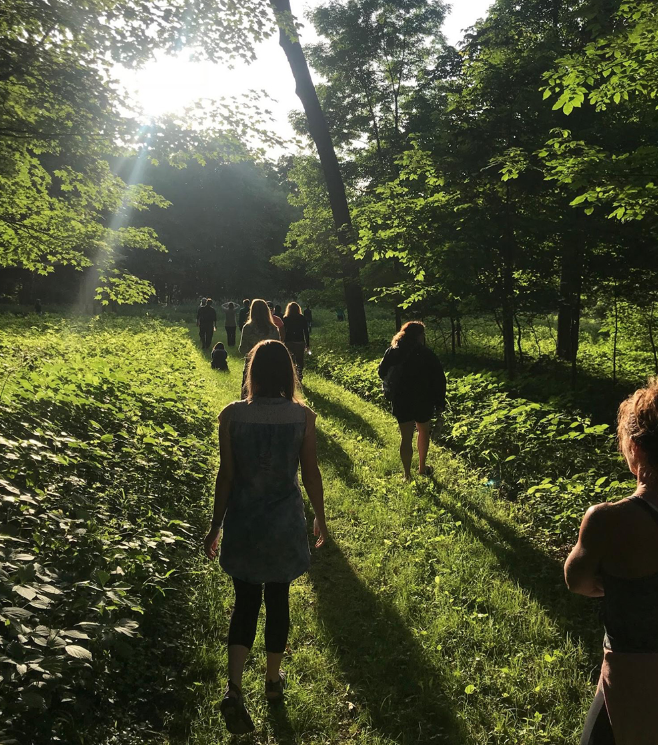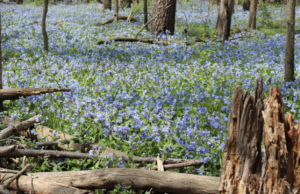SHINRIN-YOKU – Forest bathing provides benefits for health

Dr. Suzanne Bartlett Hackenmiller takes her patients forest bathing, opening their minds and eyes to the beauty and benefis of relaxing in nature.
During the cold winter months when ice covers the streets and snow piles high on roofs, people are told to stay inside, don’t go on the roads and be safe. But in the summer parents yell at kids who sit in a dark room playing video games to go outside and climb a tree. This can be misleading because it is just important to soak up the sun and experience nature in both scenarios.
Getting outdoors is important all throughout the year for many reasons. One being the benefits the sun provides. The ultraviolet rays from the sun kickstart vitamin D synthesis in bodies when the rays hit the skin. Without vitamin D, which is essential for bone growth, one’s bones can become misshapen, brittle and break easier.
Nature itself, including the trees and the soil, also provides mental and physical health benefits. “We {Dr. Qing Li} have found that there are chemicals emitted from trees called phytoncides. They’re highest in evergreens, which is good because that means you can even get them in the winter if you’re in the vicinity of evergreen trees,” Suzanne Bartlett Hackenmiller, M.D., an OB-Gyn and Integrative Medicine physician, said. “They have found that we inhale these chemicals, and it’s these phytoncides that are responsible for reducing inflammation, fighting infections both bacterial and viral and also increasing these natural killer cells (which help fight cancer,)” she said.
The soil also plays a role in increasing important body functions. A study done by Matthew Jenks found that bacteria called mycobacterium vaccae that is found in soil improves memory and brain cognition as well as reducing anxiety. People are exposed to this bacteria through touching the soil or inhaling it.
Hackenmiller also said that the absorption of vitamin D affects mood and can be the cause of “seasonal depression” or Seasonal Affective Disorder in the winter when people don’t get outside much. “I have a lot of issues with winter. I think there are a number of reasons for that. You know, we get vitamin D from the sun, and it helps with our mood. I definitely think it’s a problem, and people in colder climates definitely seem to have a lot more mental health problems, and also physical and medical. I think that might be part of it because half of the year we are stuck inside,” she said.
The importance of spending time in nature for mental and physical health was first realized in the 1980s in Tokyo by researchers, Dr. Quing Li and Dr. Yoshifumi Miyazaki. They saw that Tokyo was a city known for traffic, loud noises, high stress, a lot of technology and not a lot of green. They started taking people out in the woods to try and get rid of the stress that the environment in Tokyo creates. During these prescribed walks in the woods, they would teach people how to take in nature through their senses. They called this “forest bathing” or “Shin-Yoku.” Now in Japan they have trains that take people from the center of Tokyo to the woods.
During the time Dr. Li and Miyazaki first started taking people on forest walks, they would record their blood pressure, cortisol levels (measures stress) and their salvitaries. They found that when people spent time in nature, these things improved.
Hackenmiller is an official guide and medical director of the The Association of Nature and Forest Therapy, which was started by Amos Clifford, who brought the idea of forest bathing form Japan in the early 2000s.
“My work for them is taking people out in these walks in nature typically for two, two and a half to three hours. We give them these prescribed, what we call “invitations” where we guide them to take nature in through the senses,” Hackenmiller said. “Sometimes I’ll have them do a visual invitation where I’ll have them notice maybe the dark instead of the light. I’ll have them do different auditory things where we’re listening in different directions maybe or we’re listening in a different kind of way to notice different sounds in our surrounding. We do a lot of tactile things where I may ask them to take their shoes off and walk barefoot or put their hands up on a tree or really lean on or hug a tree.”
Hackenmiller got interested in nature therapy through her personal interest in outdoor adventures like running, hiking, cross country skiing, as well as her integrative medicine practice and her personal practice of mindfulness. “I do a lot of mountain biking and trail running and kayaking and hiking. I’ve always found that to be therapeutic for myself, just being outdoors exercising,” she said.
Hackenmiller has seen through her profession of nature therapy an increase in mental and physical health in her patients. ‘I’ve seen people with mental health have effects, where they report problems of depression, anxiety or insomnia, and after a couple of hours they find that that has improved. I’ve seen people who have chronic pain that after two hours of this forest therapy, that they are no longer having pain,” she said. “I, of course, think it’s important to keep spending time in nature because I think all of these things dissipate over time.”
To help fight the depression that can be brought on by the lack of vitamin D and the overall benefits nature provides, Hackenmiller suggests getting outside every day. “Get outside, even if you’re bundled up. Even for 10 minutes, it can really help boost your mood,” she said.
This upcoming spring Hackenmiller will be releasing a book on the topic of nature therapy. It will be called “Outdoor Adventure Guide on Forest Bathing.” It will incorporate outdoor adventures with the slower, quieter practice of forest bathing, as well as herbal medicine.









You must be logged in to post a comment Login